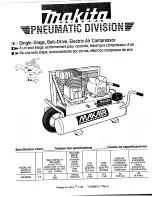
Airmac Owner’s Manual
August 2006
© Glenco Manufacturing Pty Ltd
Page 34 of 44
TABLE 5
TROUBLESHOOTING CHART
Symptom
Possible Cause
Corrective Action
13. 240 V: Blown start and/or
run capacitors. Damaged
motor cowl and/or fan.
Other motor faults.
14. 415 V: Damaged motor
cowl and/or fan. Other
motor faults.
15. V-belts too tight or
misaligned.
16. Compressor pump
partially or totally seized.
13. 240 V: Check both
capacitors and replace as
required. Replace motor
cowl and/or fan. Replace
motor.
14. 415 V: Replace cowl
and/or fan. Replace
motor.
15. Adjust belts to proper
tension and alignment.
16. Repair or replace
compressor pump.
Engine will not start or
cranks slowly.
1. No fuel in tank.
2. Fuel supply valve closed.
3. Engine control switch off.
4. Low oil pressure.
5. Engine not grounded
properly.
6. Old fuel or water in fuel.
7. V-belts too tight or
misaligned.
8. Compressor pump
partially or totally seized.
9. Engine fault.
1. Add fuel.
2. Open fuel supply valve.
3. Turn on control switch.
4. Add oil.
5. Ground battery to engine
as recommended.
6. Replace fuel and add fuel
stabilizer.
7. Adjust belts to proper
tension and alignment.
8. Repair or replace
compressor pump.
9. See engine manual.
Compressor pump does not
come up to speed.
1. Loose engine/motor
pulley, loose compressor
pump pulley, or
loose/worn V-belts.
2. Low supply voltage.
3. Use of extension lead.
4. Engine throttle control not
opening fully or engine
fault.
5. Damaged or worn
1. Tighten or replace pulleys
as required, check
alignment and adjust V-
belt tension.
2. Check no load and full
load supply voltage.
Upgrade power supply
circuit if required.
Disconnect any other
appliances on the same
supply circuit.
3. Do not use extension
lead. Use longer air hose
with larger diameter.
4. Adjust or replace throttle
cable. See engine
manual for other action.
5. Replace compressor











































